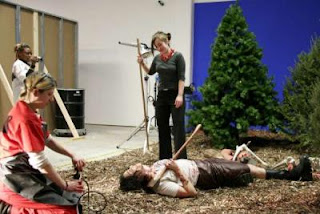
Teena McClelland and Michelle Maynard on the set of Death by Design, Co. at Gallery 400 in 2006.

Teena's in* interior interventions headquarters in 2004
In* Interior Interventions is a business that provides customers with an unconventional interior design service. With the help and consultation of Teena McClelland, founder of In*, clientele have their homes redesigned to be completely nonfunctional. Recently, Teena has been collaborating with Michelle Maynard to create Death by Design Co., which provides participants the chance to star in their own horror flick. In Michelle's previous work, she wrote, produced and starred in her own horror movie "Throb". I started to become more interested in Teena and Michelle's work while studying relational aesthetics in graduate school, so I asked Teena if she would answer a couple questions.
(Cole)
Your projects seem to take place in a post-Rirkrit form of Relational Art, where you offer a service, but the service is very
unconventional. I'm thinking Death by Design, as well as thenonfunctional interior design project in 2004. I'm using Rirkrit
Tiravanija as an example because his practice of inserting the everyday into an institutional setting is designed in a way that suggests there is no separation between the two spheres. In Rirkrit's case we notice the difference after the fact, so we notice how an art gallery changes a dinner party. In your case, it seems that you approach a project with the knowledge that the everyday will be affected or transformed when it is placed in a gallery or museum. So you offer a service of redesigning my closet so I can't reach my clothes. Am I on the right path here? Are your unconventional services a comment on service-based artworks, contract-art and the history of relational aesthetics? Or, does it come out of a reaction to economics and the service industry expanding into every nook and crevice?
(Teena)
My ideas for my work employ similar sentiments to Rirkrit Tiravanija's motives of creation, for sure. Rirkrit creates a situation in the gallery which is not about looking at art--but it is about "being in a space, participating in an activity, and the nature of the visit has shifted to emphasize on the gallery as a space for social interaction." My "businesses" exist as installations in galleries much like Rirkrit's aftermath they "function like scientific experiments: the displacement becomes a tool and exposes the way scientific thought processes are constructed. The visitor becomes a participant in that experiment."
There is a difference here between Rirkirt and I. The businesses I create are earnest establishments which have little choice but to exist in the art gallery (since another venue does not exist for such services just yet) and these businesses are often seen only as an "experiment" and are somewhat hindered in their mainstream ability because they cannot get a foothold in the commercial business realm. Ideally, my in* interventions interior design firm would have existed in a real commercial/retail space where it offered the new formula I employed for interior decorating.
ESTABLISHED FORMULA:
home decor and arrangement--
ESTABLISHED BY--beauty/functionality/order=successful interior design
MY in* FORMULA:
home decor and arrangement--
ESTABLISHED BY--narrative/catastrophe/disorder=successful in* interior
design
So, here you see the idea of Rirkrit and that idea's attempt to use a formula to displace the audience and teach or show the opportunity of using an established context/site in a new way--but I am not interested in merely using it against/for the gallery or art itself. That is just the venue it is allowed to exist in at this time. And often that venue works out fine.
(Cole)
The two of you collaborating has complicated both of your practices, in a good way. Teena's twisted sense of the service economy is now more sinister, and Michelle's horror flick is now participatory. Sorry for this very generic question, but how do feel about this combination? What do you think this says about art that takes the form of a service or a social contract?
(Teena)
The projects in* and Death by Design, CO. are serviced-based as a draw for participants--Services are active and participatory and not static and stable. My main intention while working as an artist-is the idea of involving others, perhaps directly, especially others who might not normally be engaged in artwork/artworld. Ta da--so offer them a service! and then they will be part of the project and the project will rely on them...and even in the project's failure-no willing participants- we can find success (this is a longer conversation). Therefore, collaboration occurs not only with Michelle Maynard, who
will collaborate on the initial structure of the formula (the set, menu, contracts, methods of making and selling), but there is a collaboration with clients and with staff and with the gallery--and they all get to shape the outcome by adding their own to the initial formula.
Achieving entertainment is one key to all of this working out (entertainment can be the goal for a project and it can still have
valuable side effects) and it doesn't hurt to make it official by calling it a "business". That definitely adds an air of expertise to the whole package. In some ways, Death by Design, Co. allows Michelle to do what she would like to do most and allows me to do what I would like to do most. I would like for people to face a situation that I have arranged and leave that situation thinking that they must reposition themselves in relation to what is being dealt with--much like the goal of Rirkrit. I am optimistic and I hope for the best, for something to happen--and these services and spectacles seem like the clearest path for some kind of direct affect on the audience/participant.
http://www.deathbydesignco.com/flash.html